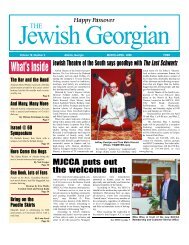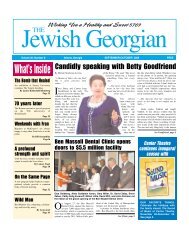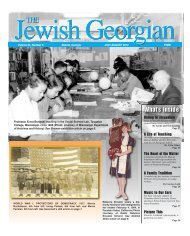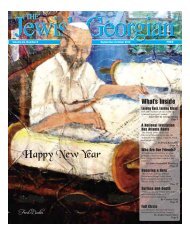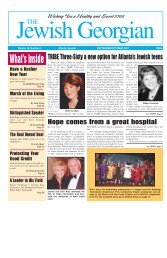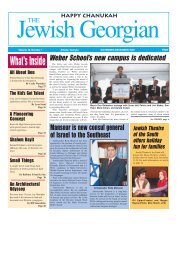You also want an ePaper? Increase the reach of your titles
YUMPU automatically turns print PDFs into web optimized ePapers that Google loves.
November-December 2010 THE JEWISH GEORGIAN Page 7<br />
Doctor<br />
From page 1<br />
Foundation, is one of the country’s leading<br />
philanthropists.<br />
<strong>The</strong> story begins when Marcus sought<br />
out the professional services of Malizia. At<br />
that time, Dr. Malizia was in private practice<br />
in the Atlanta area and had been treating<br />
patients for over 20 years. What resulted<br />
was a successful medical treatment,<br />
administered in a personal and caring manner,<br />
and a friendship that was to be the seed<br />
of a vision that germinated into the Malizia<br />
Clinic.<br />
<strong>The</strong> medical treatment that Marcus<br />
received was successful, but, putting health<br />
considerations aside, what really sparked<br />
Marcus’s interest was the way the staff<br />
interacted with him and met his needs. We<br />
all know that in the operation of <strong>The</strong> Home<br />
Depot, Marcus always stressed the importance<br />
of the customer and the need for <strong>The</strong><br />
Home Depot employees to be accommodating,<br />
concerned, and responsive. He was a<br />
major factor in inculcating the staff with an<br />
understanding that it was not just the availability<br />
of the product that brought the customer<br />
back; it also was the treatment that<br />
the customer received from trained, knowledgeable<br />
personnel. He soon realized that<br />
Malizia shared this same philosophy in the<br />
dispensing of medical services and that they<br />
were kindred spirits in this regard.<br />
Thus, in 2004 began a five-year<br />
odyssey that resulted in <strong>The</strong> Malizia Clinic.<br />
Marcus, in concert with a group of former<br />
and current patients of Malizia, put together<br />
a plan to build and expand on Dr.<br />
Malizia’s model of extraordinary care with<br />
outstanding service. This resulted in the formation<br />
of a 501(c)(3) not-for-profit medical<br />
clinic, similar to Mayo Clinic (where Dr.<br />
Malizia trained) and Cleveland Clinic models.<br />
More than $25,000,000 was committed<br />
by those involved in the implementation of<br />
the concept. A board of directors, all<br />
patients of Dr. Malizia who shared the same<br />
vision for the clinic, was put in place. <strong>The</strong><br />
members of this board—whom Marcus<br />
Breman<br />
From page 1<br />
become one of legend, yet few <strong>Georgian</strong>s<br />
are aware of Isidor’s native roots.<br />
Isidor’s father, Lazarus Straus, immigrated<br />
to the United States from Germany in<br />
1852 and immediately headed South,<br />
where he heard there were better economic<br />
opportunities awaiting retailers.<br />
Originally settling in Oglethorpe,<br />
Georgia, he began his career as a peddler,<br />
often passing through Talbotton.<br />
Impressed with the community, he decided<br />
to move to Talbotton and established<br />
three stores in the area. By 1854, Lazarus<br />
was able to bring his wife, Sarah, and<br />
their four children, Isidor, Hermine,<br />
Nathan, and Oscar, to America.<br />
In 1861, when the Civil War began,<br />
credits with playing roles of equal importance<br />
as his through their dedication, hard<br />
work, and financial support—are:<br />
• Dan T. Cathy, president and COO of<br />
Chick-Fil-A;<br />
• Robert W. Fisher, chairman and CEO of<br />
Investors Equity and Wesley International;<br />
• Judge G. Conley Ingram, Cobb County<br />
Superior Court judge and former Georgia<br />
Supreme Court justice;<br />
• Howard M. Jenkins, previous CEO and<br />
present chairman of Publix Super Markets;<br />
• Anthony A. Malizia, Jr., M.D., president<br />
and clinic director of <strong>The</strong> Malizia Clinic;<br />
• Bernie Marcus, founding chairman of <strong>The</strong><br />
Malizia Clinic, co-founder of <strong>The</strong> Home<br />
Depot, and chairman of <strong>The</strong> Marcus<br />
Foundation;<br />
• Robert S. Martin, chairman and CEO of<br />
Boar’s Head Provisions Company; and<br />
• Frederick S. Slagle, executive director of<br />
<strong>The</strong> Marcus Foundation.<br />
Marcus served as the founding chairman<br />
of the board, a designation he retains,<br />
and continues as a director. For the last four<br />
years, Howard Jenkins has served as board<br />
chair, and he and Marcus together have<br />
been the primary financial resource for the<br />
clinic.<br />
What an impressive story. Parroting<br />
some of the TV infomercials: “But wait,<br />
Isidor, the eldest of the four Straus children,<br />
was sixteen years old. It was during<br />
the war, when Southern families were<br />
suffering from deprivation due to the<br />
Federal blockade of goods, that the<br />
<strong>Jewish</strong> merchants in Talbotton were confronted<br />
with their first taste of anti-<br />
<strong>Jewish</strong> feeling.<br />
Because of the blockade, supplies<br />
were limited, and prices rose. All merchants<br />
were responsible for the increase,<br />
but the <strong>Jewish</strong> merchants were singled<br />
out in a statement by the grand jury and<br />
charged with speculating. After ten years<br />
in Talbotton, the Straus family no longer<br />
felt welcome and moved to Columbus,<br />
Georgia, where they stayed for the duration<br />
of the war. In 1865, they moved<br />
again, this time to Philadelphia, and<br />
finally to New York.<br />
Using their connections with<br />
that’s not all.” <strong>The</strong> vision for the clinic was<br />
that it was to be more than a urological doctor’s<br />
office: it was to be a full-blown medical<br />
facility that encompassed “advanced<br />
post-graduate training for experienced surgeons<br />
that is not currently available in academic<br />
medical centers or limited continuing<br />
medical education programs”; research programs<br />
on “advancing surgical techniques<br />
and procedures, surgical instrument design<br />
and development”; and a place to conduct<br />
trial research.<br />
<strong>The</strong> physicians work on a salary basis<br />
so that they can be patient-centered and<br />
focused on the care and needs of the patient<br />
rather than driven by economic necessity to<br />
have a high volume of cases. Because of the<br />
beginning capital that has been made available,<br />
the clinic is able to offer desirable<br />
compensation packages, enabling it to<br />
attract leading professionals in the field. J.<br />
Gilbert Foster, Jr., MD; Ray Pak, MD,<br />
Jaime Wong, MD, and Alienor Gilchrist,<br />
MD, who soon will join the staff, all share<br />
the patient-care philosophy of the clinic and<br />
have been and are a critical element in what<br />
the clinic stands for. Each brings his or her<br />
own dynamic to the institution, and Dr.<br />
Malizia pointed out that “Dr. Foster has<br />
played a very important role in complementing<br />
my weaknesses, giving me bal-<br />
European manufacturers of china and<br />
pottery, the family leased a department<br />
from R.H. Macy. Soon thereafter, Isidor<br />
Strauss was asked to become one of the<br />
partners of the entire store. When Mr.<br />
Macy died, Strauss became chief executive<br />
officer. Under the direction of Isidor<br />
Straus, Macy’s became the first department<br />
store in the United States to make a<br />
million dollars in sales in one day.<br />
Isidor Straus, in fact, was so successful<br />
that he was able to afford the costly<br />
first-class tickets for his wife and himself<br />
on the Titanic’s maiden voyage, in 1912.<br />
On a visit to New York in April of<br />
2009, Tom Asher, a member of <strong>The</strong><br />
Breman’s Board of Directors, was visiting<br />
his long-time friend John Herzog,<br />
chairman and founder of the Museum of<br />
American Finance. Mr. Asher was developing<br />
an exhibition and timeline at the<br />
ance, confidence, and guidance.” <strong>The</strong> startup<br />
capital has also permitted the clinic to<br />
acquire the latest, most modern equipment<br />
with which to treat patients. What a great<br />
formula: top-flight professionals, the most<br />
modern equipment, and attention to patient<br />
care without time constraints.<br />
<strong>The</strong> clinic, which opened in August of<br />
2009, presently occupies approximately<br />
15,000 square feet of space in the new<br />
Piedmont West Building on Howell Mill<br />
Road and is dedicated to the urological<br />
practice. This is just the beginning, though.<br />
<strong>The</strong>re is an option to take another floor with<br />
approximately the same amount of space to<br />
expand the services into the gynecological<br />
field and other related specialties, as funding<br />
becomes available. <strong>The</strong> hope and plan is<br />
to grow <strong>The</strong> Malizia Clinic into a major<br />
national presence in the health care arena.<br />
In addition to patients from Atlanta and<br />
Georgia, it is envisioned that individuals<br />
from the entire U.S. and the world will be<br />
treated.<br />
As I was leaving the clinic, Dr. Malizia<br />
wanted to make the point that one reason<br />
for the formation of the clinic as a not-forprofit<br />
entity was to be able to offer treatment<br />
to people from all economic strata. He<br />
was particularly interested in making sure<br />
that the <strong>Jewish</strong> community knew that<br />
through a committee-based Charity Care<br />
Program, services are available for those<br />
who are not covered by insurance plans in<br />
which the clinic participates.<br />
<strong>The</strong> doctor and the visionary. How fortunate<br />
for Atlanta’s reputation as a center<br />
for medical care; how fortunate for those<br />
who need these services; and how fortunate<br />
for those individuals whose economic limitations<br />
may have made obtaining this level<br />
of care remote. <strong>The</strong>re is a commitment not<br />
to compromise the quality of care: the only<br />
limiting factor is the amount of funding that<br />
is available to help those who need financial<br />
assistance. It is hoped and anticipated<br />
that continuing donations will enable the<br />
clinic to step up its activities for those in<br />
need, regardless of economic circumstances.<br />
College of Management at Georgia Tech<br />
on the history of Wall Street, and the<br />
Museum of American Finance was assisting<br />
him with his research.<br />
On a tour of their archives, Mr. Asher<br />
spotted the portrait of Isidor Strauss, who<br />
was a director at the Hanover National<br />
Bank in New York from 1885 until his<br />
death on the Titanic in 1912. Knowing of<br />
Strauss’ Georgia roots, Mr. Asher asked<br />
if the portrait might be deaccessioned<br />
from the collection at the Museum of<br />
American Finance and purchased for <strong>The</strong><br />
Breman. After a year of discussion, the<br />
collections committee of the Museum of<br />
American Finance decided to allow Mr.<br />
Asher to buy the painting.<br />
We can now say that Isidor Strauss<br />
has, in part, returned to his Georgia roots.



